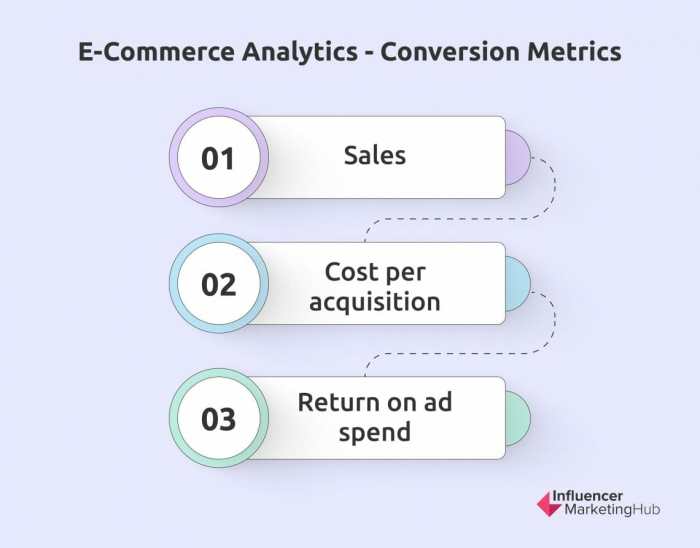Understanding E-commerce Conversion Metrics sets the stage for optimizing online businesses, diving into essential metrics and strategies that drive success in the digital realm.
From decoding conversion rates to enhancing user experience, this topic sheds light on the critical aspects of e-commerce performance evaluation.
Importance of E-commerce Conversion Metrics: Understanding E-commerce Conversion Metrics

Understanding e-commerce conversion metrics is crucial for online businesses to track and optimize their performance. By analyzing these metrics, companies can make data-driven decisions to improve their website’s effectiveness and increase sales.
Key Conversion Metrics
- Conversion Rate: This metric measures the percentage of website visitors who take a desired action, such as making a purchase or signing up for a newsletter. A high conversion rate indicates that the website is effectively converting visitors into customers.
- Cart Abandonment Rate: This metric measures the percentage of visitors who add items to their shopping cart but leave the website without completing the purchase. A high cart abandonment rate can indicate issues with the checkout process or pricing.
- Average Order Value (AOV): AOV measures the average amount customers spend per order. By increasing the AOV, e-commerce businesses can boost their revenue without acquiring additional customers.
- Customer Lifetime Value (CLV): CLV predicts the total revenue a business can expect from a single customer throughout their entire relationship. By focusing on increasing CLV, businesses can prioritize customer retention and loyalty.
Impact on Decision-Making and Strategy Planning
E-commerce conversion metrics play a significant role in decision-making and strategy planning for online businesses. By analyzing these metrics, companies can identify areas of improvement, optimize their marketing campaigns, and enhance the overall user experience on their website. For example, if the cart abandonment rate is high, businesses can implement strategies to improve the checkout process and reduce friction for customers, ultimately leading to higher conversion rates and increased sales.
Common E-commerce Conversion Metrics

In the world of e-commerce, there are several key metrics that businesses use to evaluate the performance of their online stores. These metrics provide valuable insights into how well a website is converting visitors into customers and generating revenue. Let’s dive into some of the most common e-commerce conversion metrics and understand their significance.
Conversion Rate
The conversion rate is a crucial metric that measures the percentage of website visitors who take a desired action, such as making a purchase. It is calculated by dividing the number of conversions by the total number of visitors and multiplying by 100. A high conversion rate indicates that your website is effectively turning visitors into customers, while a low conversion rate may signal issues with the user experience or product offerings.
Bounce Rate
The bounce rate measures the percentage of visitors who navigate away from a website after viewing only one page. A high bounce rate can indicate that visitors are not finding what they are looking for or that the website has issues with usability or relevance. To calculate the bounce rate, divide the number of single-page visits by the total number of entries to the website and multiply by 100.
Average Order Value
The average order value is the average amount of money customers spend on each transaction. It is calculated by dividing the total revenue by the number of orders. Monitoring the average order value can help businesses identify trends in customer spending habits and optimize their pricing strategies to increase revenue.
Cart Abandonment Rate
The cart abandonment rate measures the percentage of online shoppers who add items to their shopping cart but leave the website without completing the purchase. This metric is calculated by dividing the number of completed purchases by the number of initiated transactions and multiplying by 100. A high cart abandonment rate can indicate issues with the checkout process or unexpected costs that deter customers from completing their purchase.
Customer Lifetime Value, Understanding E-commerce Conversion Metrics
Customer lifetime value (CLV) is a metric that predicts the total revenue a business can expect from a single customer over the course of their relationship. It takes into account factors such as repeat purchases, average order value, and retention rates. Calculating CLV can help businesses tailor their marketing efforts to maximize customer loyalty and long-term profitability.
Improving Conversion Rates
To improve conversion rates, businesses need to focus on analyzing conversion metrics and making data-driven decisions to optimize their online platforms. By understanding user behavior and preferences, companies can implement strategies that enhance the overall shopping experience and increase the likelihood of conversions.
Role of User Experience
User experience plays a crucial role in improving conversion rates. A website that is easy to navigate, visually appealing, and responsive on all devices can significantly impact user engagement and ultimately lead to higher conversion rates. By conducting user testing and gathering feedback, businesses can identify areas for improvement and make necessary adjustments to enhance the overall user experience.
Website Design and Product Placement
The design of a website and the placement of products can influence conversion rates. By optimizing the layout, colors, fonts, and imagery, businesses can create a visually appealing and cohesive online platform that encourages users to make a purchase. Additionally, strategic product placement, such as highlighting best-selling items or offering personalized recommendations, can help drive conversions and increase sales.
Case Studies and Success Stories
There are numerous examples of businesses that have effectively increased their conversion rates through data-driven decisions. For instance, an e-commerce company optimized its checkout process based on conversion metrics and saw a significant increase in completed transactions. Another business improved its product pages by adding customer reviews and ratings, leading to higher conversion rates and customer satisfaction. These success stories highlight the importance of analyzing conversion metrics and making informed decisions to drive business growth.
Tools and Analytics for Tracking Conversion Metrics
Tracking e-commerce conversion metrics is crucial for optimizing online businesses. Utilizing the right tools and analytics platforms can help businesses measure, analyze, and improve their conversion rates effectively. Real-time data tracking and monitoring play a significant role in making informed decisions to enhance conversion rates.
Popular Tools and Analytics Platforms
- Google Analytics: A widely used tool that provides detailed insights into website traffic, user behavior, and conversion metrics.
- Kissmetrics: Focuses on customer behavior analysis, allowing businesses to track individual user journeys and optimize conversions.
- Hotjar: Offers heatmaps, session recordings, and surveys to understand user interactions and identify conversion bottlenecks.
- Crazy Egg: Provides heatmaps, scroll maps, and click reports to visualize user engagement and improve conversion paths.
Utilizing Tools for Measurement and Analysis
Utilizing these tools allows businesses to track key performance indicators (KPIs), such as conversion rates, bounce rates, and average order value. By analyzing the data provided by these tools, businesses can identify trends, user preferences, and areas for improvement to optimize their conversion metrics effectively.
Importance of Real-Time Data Tracking
Real-time data tracking enables businesses to monitor website performance, user interactions, and campaign effectiveness promptly. By having access to up-to-date data, businesses can make informed decisions, implement quick changes, and test strategies to improve conversion rates instantly. This agile approach to data analysis and optimization is essential in the fast-paced e-commerce environment.





